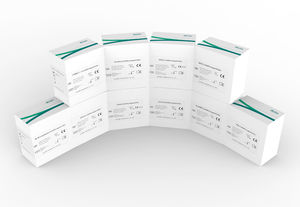
- Laboratory
- Laboratory medicine
- Prostate cancer test kit
- Autobio Diagnostics
Prostate cancer test kit oncologygeneticprostate-specific antigen
Add to favorites
Compare this product
fo_shop_gate_exact_title
Characteristics
- Applications
- for prostate cancer
- Application field
- oncology
- Tested parameter
- genetic, prostate-specific antigen, fPSA
- Sample type
- clinical
Description
Prostate cancer is the second most frequent cancer and the fifth leading cause of cancer death among men in 2020. For a disease as common as prostate cancer, relatively little is known about its etiology. Established risk factors are limited to advancing age, family history of this malignancy, and certain genetic mutations (eg, BRCA1 and BRCA2) and conditions (Lynch syndrome). [1] prostate-specific antigen (PSA) is the most widely used tumor maker in prostate cancer. Multi-center study found that the percentage of fPSA and PSA help to detect early prostate cancer.
Clinical Significance
PSA is the most important marker of prostate cancer and is widely used in early detection, aiding diagnosis and recurrence monitoring. Men with a PSA >1 ng/ml at age 40 yr and >2 ng/ml at age 60 yr are at increased risk of PCa metastasis or death several decades later. It is recommended that PSA testing can be taken into account in every 2 years for men at increased risk[2,3].
When PSA is between 4-10ng/ml, the fPSA level is negatively correlated with the incidence of prostate cancer. If fPSA/tPSA,0.25, the probability of prostate cancer is only 8%.
Catalogs
No catalogs are available for this product.
See all of Autobio Diagnostics‘s catalogsRelated Searches
- Autobio test kit
- Solution reagent kit
- Autobio blood test kit
- Autobio serum test kit
- Plasma assay kit
- Infectious disease detection kit
- Diagnostic reagent kit
- Respiratory infection test kit
- Autobio clinical test kit
- COVID-19 detection kit
- Clinical chemistry analyzer
- Bacteria reagent kit
- Antigen assay kit
- Clinical reagent kit
- Automatic clinical chemistry analyzer
- IgG test kit
- Benchtop clinical chemistry analyzer
- Laboratory detection kit
- Autobio cancer test kit
- Autobio cell test kit
*Prices are pre-tax. They exclude delivery charges and customs duties and do not include additional charges for installation or activation options. Prices are indicative only and may vary by country, with changes to the cost of raw materials and exchange rates.









